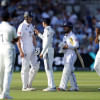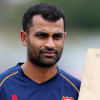Too soft, too Soon: Dukes ball under fire in England-India series

The Dukes ball, a longstanding staple of Test cricket in England, has come under intense scrutiny during the ongoing England-India series, following a spate of issues that have disrupted play and frustrated players.
Persistent complaints about the ball losing shape and going soft prematurely have prompted the England and Wales Cricket Board (ECB) to take action. After widespread problems in the first three Tests, including multiple ball changes, the ECB is collecting as many used balls as possible and will send them to manufacturers British Cricket Balls Ltd. for a detailed examination.
"We will take it away, inspect, and then start talking to the tanner, talking about all of the raw materials, everything," said Dilip Jajodia, owner of British Cricket Balls Ltd., which manufactures the Dukes. "Everything we do will be reviewed, and then if we think some changes need to be made or tightened up, we will."
The decision comes after a chaotic third Test at Lord's, where five balls were changed during England's first innings alone. One ball was replaced after just 10.2 overs on the second morning.
First introduced in 1760, the Dukes ball has long been considered one of the finest in the game. Its traditional hand-stitched seam and quality leather casing have earned it global prestige. However, in recent years, questions have emerged over its durability and consistency in both international and county cricket.
"The cricket ball should be like a fine wicketkeeper, barely noticed," former England seamer Stuart Broad said. "We are having to talk about the ball too much because it is such an issue and is being changed virtually every innings. Unacceptable. It has been like this for five years now. Dukes have a problem. They need to fix it."
Jajodia acknowledged the concerns and pointed to several possible contributing factors, including the natural variation in raw materials and the traditional manufacturing process. The ball is crafted from cork, wound in string, encased in hand-stitched leather, sourced from cowhides dyed using specific chemicals.
"If the fibres that form the animal skin have some sort of weakness or inherent problem, that's something we can only find through inspection," Jajodia said. He also cited the COVID-19 pandemic's impact on the leather industry. "I would expect changes in personnel, some may have passed away or left the profession. Also, some chemicals may no longer be available due to companies going out of business."
Jajodia believes that the evolving nature of cricket may also be placing additional strain on the ball. "The modern game, with bigger bats, more sixes, and harder surfaces, might be contributing to the problem," he said.
He admitted the limitations of testing in cricket: "The unique nature of cricket is that you can't test the ball before it goes into play. So, if it fails, it fails in use, and at the very highest level, it's in the glare of publicity."
One proposed solution has been to allow bowlers a new ball after 65 overs instead of 80, but Jajodia acknowledged that this suggestion is unlikely to find widespread support.
"At the end of the day, we've had three Test matches, they've all been good games. We should be cautious and not rush into drastic changes," he added. "This is a product that's been going since 1760. There is no snap answer, just thorough review and improvement."
Despite the historical ties, the ECB does not hold an exclusive long-term contract with Dukes. The agreement is renewed annually, and alternatives are being explored.
In county second XI matches, a hand-stitched ball from Gunn & Moore is in use as a potential fallback. More notably, the Kookaburra, the standard ball in Australia, has been trialled in four rounds of the County Championship since 2023, partly to help England bowlers adapt to overseas conditions.
However, the results have been stark. In just two rounds played this season with the Kookaburra, matches yielded an average of 1,194.66 runs each -- a significant increase -- raising questions about its suitability for English conditions. One theory suggests the Kookaburra is better suited to harder southern hemisphere pitches, rather than the softer, seam-friendly surfaces in the UK.
The ECB's Professional Game Committee and Cricket Advisory Group are monitoring the situation closely. Their analysis includes ball-change frequency, as well as reports from captains and umpires.
"I can assure you we are on the case all of the time," said Jajodia. "I spend my life almost producing these balls. I personally pick the balls for each game. When they're new, they look like works of art — they really are. But what you don't know is what it's going to do when it's actually taking hammer, and that's the problem."

 For all latest news, follow The Daily Star's Google News channel.
For all latest news, follow The Daily Star's Google News channel. 








Comments